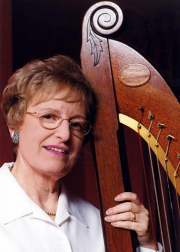|
Called in Irish cláirseach and in Scottish Gaelic clàrsach, in Welsh it is telyn, but these words
are one thing and a one thing only, the harp
The Welsh Triple Harp has three rows of strings.the two outer rows are tuned to the diatonic scale
(Like the white
keys on a piano or keyboard) and the inner to the accidentals. (Like the black or sharp notes on a piano or keyboard) making
the instrument completely chromatic. It has no pedals or mechanism at all. Sound effects unique to the triple harp can be
produced by playing the two
outer rows in swift succession, a sound which is unattainable on the large orchestral harps.
The idea of building a harp with 3 rows of strings actually came from the Italians sometime in the 16th century, where
it was developed to cope with the new styles of music that were evolving then. It was a low-headed instrument with 75 strings.
It's appeal quickly spread to France and England where Welsh harpers and harp makers in London adapted the harp with three
rows of strings and adopted it for the Welsh styles of playing.
The harp is usually rested on the harper's right shoulder, but Welsh tradition
has always been the reverse, resting
the harp on the left. And so the Continental harp was
andapted the height was increased, and the number of strings expanded
to 100. Eventually, the Triple Harp disappeared from the continent. It was difficult to both tune and play, but in Wales it
became part of the tradition, and by the end of the 18th century it became known as "The Welsh Harp"
During the 18th and 19th century, the best triple harps were made in Llanrwst, and later by Bassett Jones of Cardiff and
the harp builders of Plas Llanofer, Gwent. However, by the end of the 19th century, the pedal harp (Or "English" harp as some
called it) had supplanted the Welsh Triple harp, and by 1900 very few could play the Welsh harp, and even fewer could build
them. Thankfully 100 years later, on the Welsh Triple Harp is enjoying a revival in Wales due to the talented, dedicated and
untiring efforts of a very enthusiastic generation of harpers and craftsmen.
|
 |
|
 |
 |
|

|
|
related internet links
|
|
of the Welsh triple harp.
the online magazine
of the Gaelic harp
|
|
 |
 |
|
 |
 |
 |
|
|
 |
 |
 |
|
|
|

